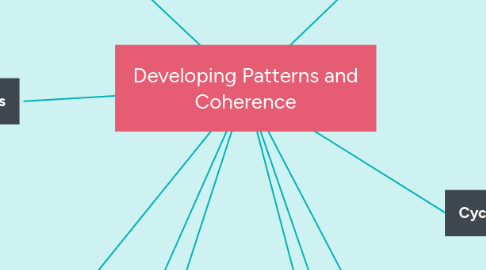
1. State Changes
1.1. attention span is the length of the child's age
1.2. when attention weakens teachers can employ state changes
1.2.1. using movement to break up academics
1.2.2. students do this on their own by looking at a window, bathroom breaks, talking
1.2.3. can also combine academics with movement
2. Crossovers
2.1. If we restrict movement we restrict processing
2.2. Crossover activities take on 3 premises
2.2.1. learning is natural and joyous
2.2.2. learning blocks make it hard to overcome stress or cope
2.2.3. We find it harder to learn nowadays because there is less movement
2.3. involve touch and movement and can be enhanced by using emotions
3. Improving Memory Links
3.1. 98% of learning is non-conscious
3.2. 5 memory pathways
3.2.1. semantic - content with context
3.2.2. episodic (memory of events)
3.2.3. conditioned response (repetition)
3.2.4. procedural (memory of skills)
3.2.5. emotional (personal experience)
3.3. Create memories through a combination of movement, emotion, visual aids and hands-on experience
4. Rough Draft
4.1. Immediate memory - first stage, holds info for 15-20 seconds
4.2. Working memory - only stored here if the information is processed as being interesting and useful
4.2.1. requires sense making, meaning and repetition
4.2.2. Includes strategies such as: timelines, venn diagrams, debating
5. Repetition
5.1. The smallest changes can confuse or links of information
5.1.1. Especially happens when something is taught through only one memory link
5.2. Involve emotion through fun, music, humor
5.3. use flowcharts and hands-on experiences
5.4. use association either by audio, visual or movement
6. Contamination
6.1. past experiences effect our current experiences
6.1.1. Effects teachers, students and parents
6.2. normal stress response is flight
6.2.1. can look like misbehavior
6.2.2. can look like incomplete work
6.3. Strategies can help manage
6.3.1. Choice in seating
6.3.2. Choice in how work is produced
6.3.3. create specific areas in the classroom for different purposes
6.3.4. guaranteed success areas
6.3.5. discipline in private
7. Cycles of Concentration
7.1. energy cycles
7.1.1. fullest energy 30-60 mins after getting up
7.1.2. cycles flow in 90-110 min
7.1.3. energy plunges in the afternoon
7.1.4. prime learning time is between 9am - 2 pm
7.2. memory cycles
7.2.1. 9-11 am builds the best short term memory (good for math, spelling, writing)
7.2.2. 12 - 2 pm is good for movement, music, etc.
7.2.3. 2-5 pm is good for social studies, lit, etc.
8. Memory Techniques
8.1. Our brain will forget most things so we must revisit
8.1.1. Use partner discourse to help with retention
8.1.2. Use physical responses
8.1.3. Use songs
8.2. Revisit with 10 mins, 24 hours and 7 days to embed in long term memory
9. Elaboration
9.1. helps deep understanding via accuracy
9.2. Happens through exploring, thinking, questioning, making mistakes, modifying, drawing conclusions
9.3. Helps students organize information in their brain - what is similar between pieces of information and what is different
10. Themes
10.1. To link info together teach in themes
10.1.1. Themes can be broken up into units

